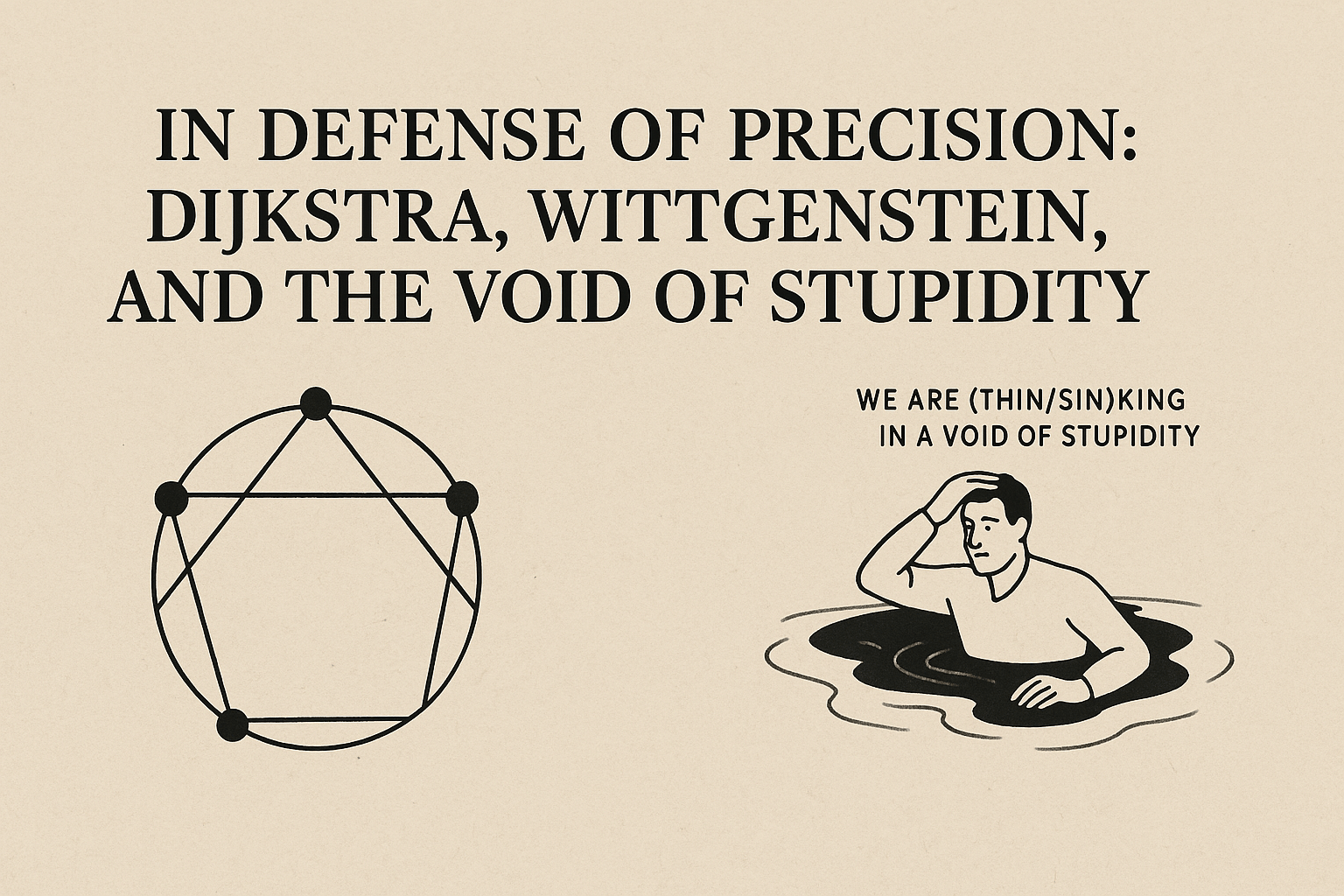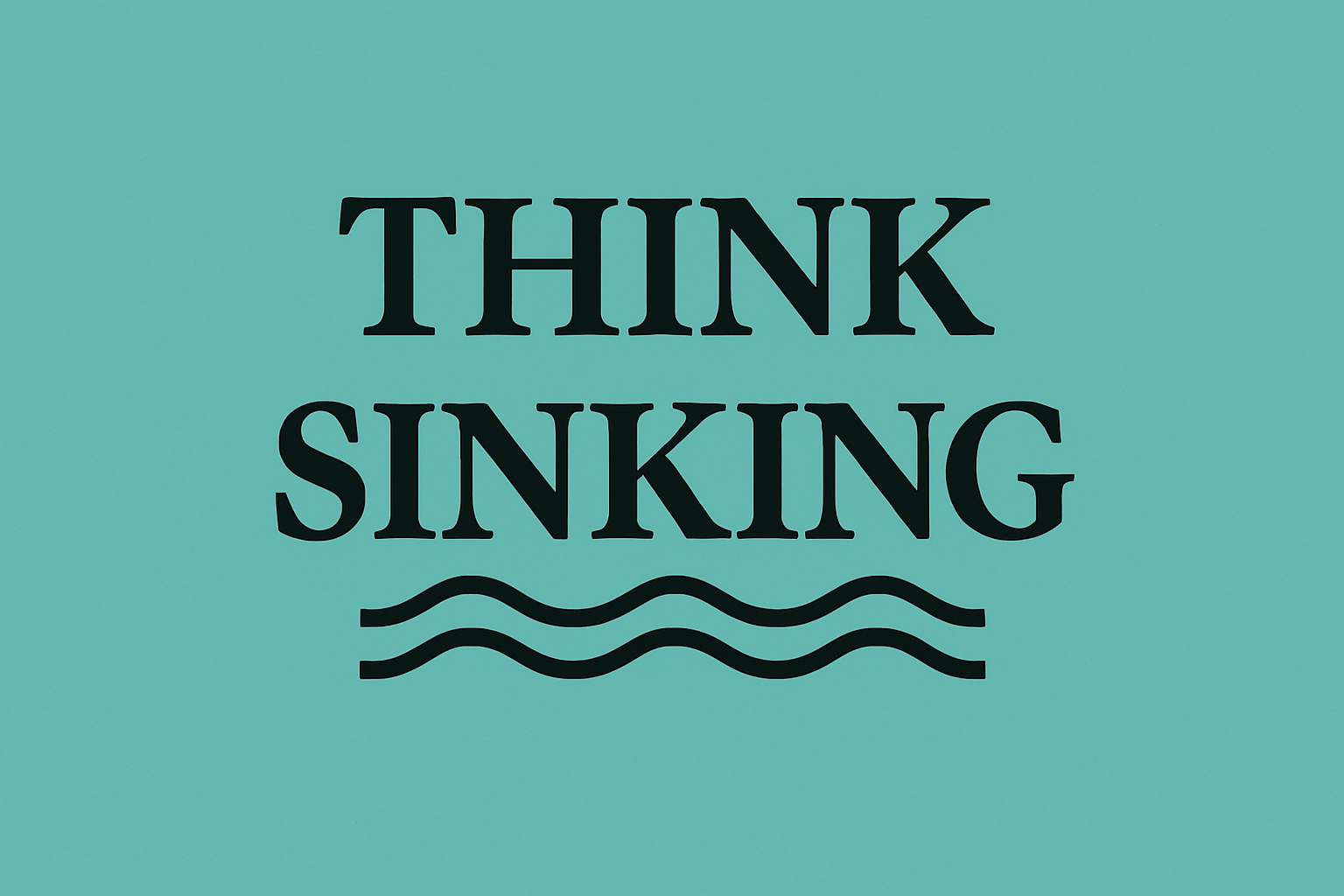- The left, in its rhetorical looseness, hollowed out the authority of precision.
- The right, seizing that vacuum, has declared war on rigor altogether. And happens to find old weapons newly sharpened by decades of unrigorous academic rhetorical theatre.
- Swap a human for an AI (and vice versa) without disruption.
- Replace one AI model with another (e.g., GPT with Claude or Gemini) seamlessly.
- Treat intelligence—whether human or machine—as a pluggable resource.
- Systems are built on APIs, not documents.
- Intelligence (human or AI) connects through clear, standardized interfaces.
- Business logic is abstracted from execution—any qualified agent can perform the task.
- API pricing and licensing shifts
- Regulatory restrictions
- Performance or ethical failures
- Modular, service-oriented architecture
- Abstracted processes with standardized inputs/outputs
- Governed, portable intelligence assets (human or machine)
- True digital maturity—not just tools, but systems thinking
- Societal crises create two potential paths: one toward progressive change and another toward reactionary repression.
- If the revolutionary path fails, the ruling class and reactionary forces use fascism to maintain control.
- Fascism does not introduce real structural change but instead reinforces existing power dynamics under the illusion of national renewal.
- Many individuals, even those in relatively comfortable positions, seem drawn to fascism not despite its destructiveness, but because of it, seeing destruction as preferable to a stagnant or flawed status quo.
- Historically, fascist movements have gained traction among people who were materially secure but ideologically discontent, preferring upheaval over continuity.
- Countering fascism requires not just rational arguments but compelling narratives and alternative visions that inspire mass movements.
- Fascists do not need to be competent to remain in power—spectacle and the perpetuation of crisis sustain them.
- Germany, France, and Italy have seen the rise of far-right parties like AfD, National Rally, and Brothers of Italy.
- Traditional conservative parties are increasingly adopting far-right rhetoric and policies.
- Anti-immigration laws, nationalism, and anti-LGBTQ+ policies are being normalized under the guise of “protecting national identity.”
- Economic policies have favored the wealthy while wages stagnate and social safety nets weaken.
- The working class and lower-middle class feel abandoned by liberal democracy, making them vulnerable to authoritarian populists.
- This mirrors Weimar Germany, where economic hardship and political instability led many to embrace the Nazi Party.
- Even among the well-off, there is a sense of dissatisfaction, leading some to embrace destruction over a flawed but stable system.
- Fact-based rebuttals alone cannot defeat fascism; only compelling counter-narratives can.
- Believing that fascists will be exposed as ineffective is a dangerous misconception—chaos and crisis sustain them.
- Congress in the U.S. is gridlocked, unable to pass significant reforms.
- The European Union struggles to respond to crises like immigration and economic stagnation.
- As democratic institutions appear ineffective, people turn to “strong leaders” who promise action—often at the cost of democracy.
- Fascists use media to sustain their movement regardless of policy success or failure.
- Failed governance does not necessarily lead to loss of power when spectacle, fear, and crisis management dominate politics.
- Fascism thrives on emotion and narrative.
- Rationality alone will not stop it.
- Only a compelling counter-vision can defeat it before it becomes fully entrenched.
- Expecting fascists to fail or be exposed as frauds is a mistake—disillusionment fuels, rather than erodes, their power.
In Defense of Precision Dijkstra Wittgenstein and the Void of Stupidity
In Defense of Precision: Dijkstra, Wittgenstein, and the Void of Stupidity

Introduction In 1978, Edsger W. Dijkstra penned a fiery and often overlooked note titled On the foolishness of ‘natural language programming’. At its core, it’s a technical argument: human languages are too ambiguous to reliably instruct machines. But between the lines, it reads like a cultural critique. Dijkstra wasn’t just concerned with programming — he was worried about thought itself.
And if we listen closely, we can hear echoes of another great mind: Ludwig Wittgenstein. From opposite ends of the intellectual spectrum, Dijkstra and Wittgenstein converged on a single, urgent theme: language shapes — and often distorts — how we think.
The Problem with Natural Language Dijkstra believed that programming is not just writing instructions for a computer; it’s writing instructions that must be perfectly unambiguous. Natural languages like English are ill-equipped for this. They’re too loose, too riddled with assumptions. A computer doesn’t “guess” what you mean — it does exactly what you say.
“The purpose of a programming language is to communicate a program and nothing else: it should be designed so as to be easily and mechanically translatable into efficient machine code.”
This demand for precision is not an arbitrary fetish — it’s a survival strategy in the world of software, where ambiguity leads to failure.
Wittgenstein and the Limits of Language Dijkstra’s frustrations parallel the two Wittgensteins: the early and the late. In the Tractatus Logico-Philosophicus, early Wittgenstein insists that language must mirror reality, and only statements with a clear logical form have meaning. This aligns neatly with Dijkstra’s formalist mindset.
But later, in Philosophical Investigations, Wittgenstein turns the tables. Language, he argues, is not a mirror but a set of practices — “language games” we play in context. Meaning is use. And while this insight illuminates the richness of human communication, it also reveals its unreliability. Words mean different things to different people. Grammar is a guideline, not a law. Precision is the exception, not the rule.
Dijkstra saw this fuzziness not as beauty, but as danger.

Example where Natural Language Fails: The Missing Predicate Problem A striking example of natural language’s limitation is its clumsy handling of multi-entity relationships. Binary predicates? Fine. Ternary? Awkward but doable. But four-place predicates? Natural language begins to break down.
R(a, b, c, d)Transaction(User1, User2, Amount, Timestamp)
Natural language, in contrast, collapses into ambiguity:
“She transferred money to him last Thursday during the conference.”
Was the timestamp about the transfer or the conference? Who exactly was involved? What counts as the event? The sentence hides more than it reveals.
This is where formal languages show their strength — not as replacements for human expression, but as tools for clarity in complexity.
The Void of Stupidity: From Formalism to Cultural Critique

Dijkstra’s critique of natural language was part of a broader fear: that rigorous analysis is being replaced by rhetorical noise. He feared a society drifting away from logic, drowning in unexamined assumptions and emotional appeals.
Fast-forward to today, and his fears feel prophetic. Public discourse has devolved into linguistic theatre. The tools of analysis are dismissed as elitist or inconvenient. Ironically, the linguistic scepticism once used by the academic left to critique power structures is now used by the populist right to undermine truth altogether.
Much of the liberal-left intellectual tradition more and more prided itself on moral sensitivity and emotional nuance — but often at the expense of analytical precision. In prioritizing feeling over form, affect over clarity, it ironically paved the way for the rise of a reactionary right that did not only hate the content of the elitist left’s ideas but learned to weaponize these same linguistic tools, only to go further: by rejecting or at least ignoring not just emotionless logic, but the very idea of objectivity, of science, of truth itself.

This is the double irony of our moment:
And now, at exactly this historical juncture, machines have begun to simulate understanding of natural language. Tools like large language models generate plausible-sounding prose with astounding fluency — but without grounding, without true comprehension, without the rigor that Dijkstra would have demanded. In doing so, they add another layer to the fog: producing yet more words, more surface coherence, more illusions of meaning.
We risk sinking deeper into the swamp — not because machines are stupid, but because they reflect our own abandonment of disciplined thought. The machines speak our language all too well. And that may be the most dangerous thing of all.
We speak about AI as if it thinks. But the real crisis is that we’ve stopped doing so. We outsource not only computation, but cognition. In a world where every question is met with a generated answer, the art of asking precise, rigorous questions — the true essence of thought — may become lost.
Worse still, we may have unlearned the very critical thinking required to detect where these machines go wrong. Having trained them on imprecise, emotionally loaded, and analytically weak data, we risk creating systems that mimic our worst habits — and lack the very structure of thought necessary for meaningful correction. We taught them to speak in a haze, and now we struggle to see through it ourselves.
Dijkstra might say: “You have taken the slippery nature of language as an excuse to abandon rigor — and now, all discourse is quicksand.”
Wittgenstein never intended his language games to justify chaos. But in the wrong hands, his insights have become cover for a dangerous relativism.
Precision as Resistance In a world where ambiguity is a political tactic and meaning is manipulated for effect, the demand for precision becomes a form of resistance. Symbolic languages — math, code, logic — are not merely technical tools. They are disciplines of the mind. They force us to say exactly what we mean, or say nothing at all.
Wittgenstein warned us of language’s limits. Dijkstra showed us the cost of ignoring them.
If we want to think clearly — and build systems, societies, and arguments that endure — we must return to precision. Because in the end, the enemy isn’t just bad code or bad grammar.
It’s bad thinking.
Speculative Future: Echoes in the Fog As we move forward, we must consider the world we are constructing — not just technologically, but epistemologically. If we continue to train machines on the detritus of our imprecise discourse, we may enter an era where machines appear articulate, but no one understands anything. Conversations will be simulations of coherence, not vessels of understanding.
In such a future, what looks like intelligence may be little more than recursion in a hall of mirrors. The danger is not that machines will think like us — but that we will forget how to think differently. That we will come to accept approximation as adequacy, and persuasion as proof.
The fight for rigor, then, is not just academic. It is existential. Precision may well become the only remaining sign of intentional thought — the last light we can trust in a fog of synthetic fluency.
Closing Thought As Wittgenstein said: “Whereof one cannot speak, thereof one must be silent.”
Dijkstra, ever the pragmatist, might have added: “Or better yet, write a compiler.”
But perhaps today we must go further:
The compiler won’t save us. Not if we don’t know how to write the spec.

Rethinking Intelligence Why True Digitalization is the Key to Resilience
Rethinking Intelligence — Why True Digitalization Is the Key to Resilience
![]()
“If I can seamlessly replace an Indian colleague with a German or an Egyptian, I should be able to swap one AI model for another just as easily. This is not just operational flexibility—it’s business continuity.”
In today’s turbulent global environment, the need for strategic resilience has never been clearer. From geopolitical shocks to rapid AI evolution, the stability of our business models is being tested on all fronts. To stay ahead, global enterprises must adopt a new mindset—one that treats both human and artificial intelligence as interchangeable and modular. But here’s the hard truth:
We will not succeed in this transformation unless we take digitalization seriously.
And let’s be clear: this is not a cold, dehumanizing exercise. Treating humans as swappable components next to AI is a dangerous, even unethical mindset—unless it is grounded in deep respect for people and supported by digital systems that protect roles, identities, and contributions. The goal is not to devalue human labor, but to build resilient systems that don’t collapse when a single contributor—human or machine—becomes unavailable.
Also, let’s not pretend this is entirely new. We’ve been augmenting human labor with machines for decades—from autopilots in aviation to industrial robotics. AI is simply the next step in that evolution. The difference now is that intelligence—whether cognitive or mechanical—is becoming integrated in more areas of work, including decision-making, language, and creative tasks. This requires a more mature, transparent, and flexible infrastructure.
AI Must Become Core, Not a Curiosity
Artificial Intelligence—particularly Natural Language Models (NLMs)—can no longer be treated as experimental add-ons. These models are becoming integral to everything from customer interaction to internal operations. To treat them as peripheral is to misunderstand their transformative power. AI is no longer optional; it’s foundational.
Diversify or Risk Dependency
Deglobalization trends are making it risky to over-concentrate operations in specific regions, talent pools, or tech providers. Just as we learned to diversify supply chains and labor markets, we now need to diversify our digital and AI assets. No single provider or platform should become a point of failure.
Interchangeability: The New Design Imperative
To future-proof operations, our systems must be designed for interchangeability:
Intelligence must be treated as a modular, portable asset—not hardwired into our workflows.
But again: this is a design and systems challenge—not a value judgment on humans. True digital systems must elevate human roles and make organizations more humane, not more transactional.
And perhaps even more important: just as an Indian can work together with an Egyptian or a German, they can—and must—work together with an AI. These relationships are not just about replacement, but about collaboration. The future is not human versus machine. It’s human and machine, side by side, contributing as colleagues toward shared outcomes.
This is not just about AI. It’s about robotics, automation, and every digital component that augments or executes work. We’ve long accepted that machines can land planes, assemble products, and navigate ships. What’s new is the scale, sophistication, and visibility of these systems in the knowledge economy. That’s why digitalization isn’t optional—it’s existential.
Digitalization Is the Missing Link
Here lies the gap:
Many organizations convince themselves they’ve “gone digital.” But what they’ve really done is digitize analog workflows—not reimagine them.
True digitalization means:
As long as we are not serious about digitalization, we will not achieve intelligence interchangeability or sustainable resilience.
This is not about simplification; it’s about managing complexity through modularity and foresight.
Human and AI Labor: Two Sides of the Same Volatility
Human labor markets are volatile: resignations, relocations, and demographic shifts create constant churn. But the same is now true for AI:
Treating both as interchangeable assets—not static dependencies—is the only way to ensure resilience. But this requires empathy, oversight, and clarity about where ethics end and efficiency begins.
What Must Be Done
To unlock this future, we must invest in:
![]()
The Future Is Flexible
The enterprise of the future won’t ask whether a task is done by a person or an AI. It will ask only: “Was it done well?”
We must build toward a reality where intelligence is modular, resilient, and swappable.
But that reality depends on something we’ve only just begun: serious, deep, uncompromising digitalization.
Let’s stop digitizing the past. Let’s start building for intelligent resilience—with systems that empower, not replace, the people behind them.
**The Rise of Fascism as a Sign of Failed Revolution: Walter Benjamin and the Present Day**

Walter Benjamin famously argued that fascism is not an independent force but rather a symptom of a failed revolution. In his Theses on the Philosophy of History (1940), he suggested that when progressive movements fail to enact systemic change, reactionary forces step in to preserve the status quo.
Today, authoritarian and far-right movements are resurging in the U.S. and Europe. By applying Benjamin’s framework, we can better understand this phenomenon as a reaction to the failures of progressive politics, economic crises, and the inability of democratic institutions to address deep societal inequalities. Strikingly, many who embrace fascist ideologies seem fully aware of their destructive consequences. Yet, rather than uphold an imperfect status quo, they opt for destruction, often at their own peril. This tendency is particularly pronounced among those who are, paradoxically, doing relatively well under the current system.
Historically, this pattern has emerged before. In the years leading up to the rise of Nazi Germany, many members of the middle and upper classes—especially those with relative security—turned toward fascism despite knowing its violent and destabilizing nature. A similar phenomenon occurred in Mussolini’s Italy, where intellectuals and business elites embraced fascism, believing it would provide order while simultaneously upending what they saw as a decaying liberal system.
At the same time, a critical mistake made by opponents of fascism is the belief that presenting factual rebuttals or exposing lies will counter its appeal. However, history shows that fascism thrives on narratives, emotions, and grand visions, not empirical arguments. Efforts to fact-check or expose contradictions often fail because fascist ideology does not rely on truth but on a compelling story that resonates emotionally with its followers. This has been evident in contemporary politics, where right-wing movements successfully frame themselves as the defenders of a threatened way of life, regardless of factual inaccuracies.
An additional misconception is the belief that once in power, fascists can be reasoned with or that their inefficacy will expose them and lead to their downfall. This is another fallacy of empiricism. Fascists do not need to be competent to remain in power—they thrive on spectacle, fear, and the continuous redefinition of enemies. Frustration and disillusionment often reinforce, rather than weaken, their grip on society. Failed policies or contradictions do not erode their support because their appeal is not based on rational governance but on the promise of destruction, renewal, and dominance.
1. Benjamin’s Thesis VII: Fascism as the Reaction to Blocked Change
Benjamin argued that fascism emerges when genuine social progress is prevented. He wrote:
“Every rise of fascism bears witness to a failed revolution.”
Key Points:
This was exactly what happened in Germany after World War I. The failure of the 1918-1919 German Revolution and the inability of social democracy to challenge capitalism allowed fascism to rise as an alternative.
Today, we see echoes of this pattern in the U.S. and Europe.
![]()
2. The Contemporary Crisis: The Rise of Fascism in the U.S. and Europe
🇺🇸 United States: Authoritarian Drift and “Project 2025”
In the U.S., there is a significant push toward centralized executive power, particularly through initiatives like Project 2025. This conservative policy blueprint, supported by think tanks aligned with the Republican Party, aims to:
✅ Restructure federal agencies to align with presidential directives. ✅ Replace career civil servants with political loyalists. ✅ Infuse government policy with conservative ideology, particularly in areas like education, climate policy, and reproductive rights.
Ruth Ben-Ghiat, a historian specializing in authoritarianism, describes Project 2025 as “a plan for an authoritarian takeover of the United States.”
🇪🇺 Europe: The Normalization of Far-Right Politics
In Europe, the situation is equally alarming:
A recent report by The Guardian highlighted how Europe is experiencing a “steady erosion of political divisions,” where the far-right is no longer an outsider movement but a legitimate political force shaping mainstream policy.
3. Why Is Fascism Rising? Benjamin’s Framework in Action
A) Economic Inequality and the Failure of Progressive Movements
B) Political Paralysis and the Weakening of Institutions
C) The Spectacle of Fascism: Manipulating Media and Public Perception
5. Conclusion: The Urgency of Now
Walter Benjamin’s warnings remain as relevant today as they were in 1940. Fascism does not emerge in a vacuum—it is the result of failed revolutions, economic injustice, and political inaction.
Understanding the present through Benjamin’s lens gives us both a warning and a roadmap: